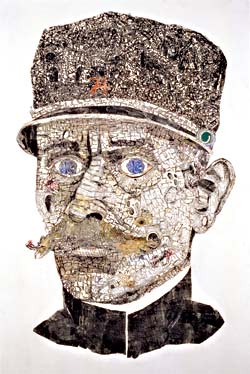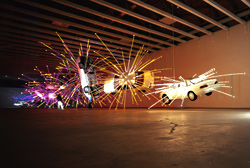The immense head will likely catch your eye from the street, even though the canvas is hanging on the far back wall of the gallery. It’s a huge, insanely intricate portrait of Gen. Esterhazy, the true culprit of the Dreyfus Affair, who slipped secret military information to the Germans in 1894—an act of which Alfred Dreyfus was unjustly accused. If you guessed this is a keyhole into the mind of Harry Clewans, a woodblock collage artist from the San Francisco Bay Area, you’d be right. Clewans’ subject matter is as arcane and fascinating as his artistic process. He creates woodblock prints of patterns from old scientific journals and work by German Renaissance artist Albrecht Dürer, which he then cuts up and rearranges in a painstaking process to re-create a psychological puzzle whose solution involves vivid portraits of historical figures and creatures. An octopus, winter trees, a man seated, a pair of crows, a golem from Hebrew folklore—some of Clewans’ works take months to complete, and when you study them up close, you can see why. His pictures look like a cross-section of earth filled with fossils. The effect is both maddening and brilliant. Embedded in the trunks of the winter trees in his Forest are medieval peasants, eyes, and Gothic buildings. The skin of his sinewy, sprawling Octopus is a pattern made from seedpods. These are large, arresting canvases, intriguing from afar, fascinating up close. They’re primarily done in monotone, with some tints of brown, green, or blue. While Clewans’ work may at first come across as bizarre—and in some cases almost grotesque—he’s creating accurate psychological portraits of people and objects covered in the barnacles of experience, and teeming with complexity beneath the surface. In this way, Clewans renders a truer portrait of the nature of things than even a photograph could produce. Gallery 110, 110 S. Washington St., 206-624-9336, <a href=
“http://www.gallery110.com”>www.gallery110.com. Noon-5 p.m. Tues.-Sat. Ends Jan. 28.








